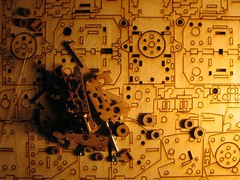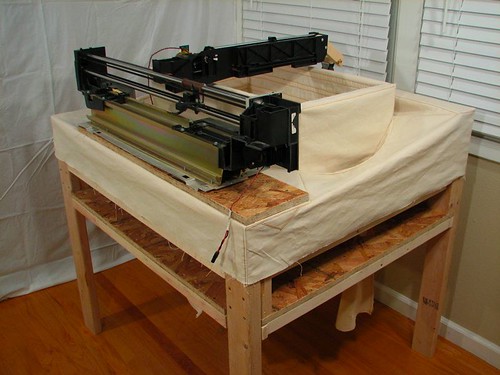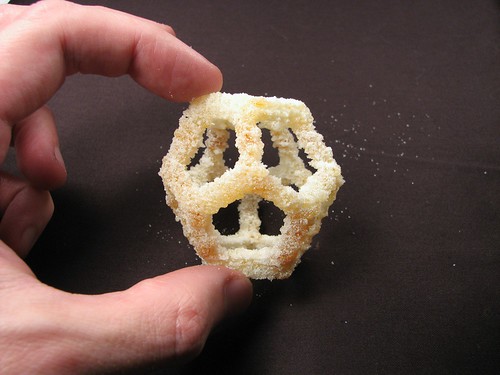
This
story in Computerworld is a couple weeks old, and I should be working harder to keep up.
Vik Olliver, a RepRap hacker in New Zealand (and probably the hardest-working RepRap hacker in the world), has now fabricated all the parts of the RepRap except the Z flag, which can be cut out of the side of a beer can. This includes only the parts that it makes sense to print on a RepRap, so it doesn't include stepper motors, nuts and bolts, pieces of metal and wood (e.g. threaded rods). But it's an important step.

I myself am still drooling a bit over some of the hobbyist CNC stuff. There's a
guy in New Mexico who sells these things on eBay. He sells aluminum ones (like this) and ones made of MDF, which I believe is a sort of particle board. Many low-end CNC machines are in the $2000 to $5000 ballpark, whereas he sells these in the $300 to $600 ballpark. It should be pretty easy to swap out that orange router and swap in an extruder.
I was thinking a bit last night about how to drive those steppers, since the offerings on eBay don't include the drive electronics. Digikey sells a stepper motor sequencer chip, the
L297, which would be used to drive some
power MOSFETs. The L297 just needs an input to choose clockwise or counter-clockwise, and a clock pulse to advance a step in that direction, so you need six
GPIO lines to control the three motors, and one more to turn on/off the router or squirt goop out of the extruder. There's some very good information on stepper motors and driver circuits
here.
It occurs to me that I've never posted the
Sourceforge download page for the RepRap design files. A shocking oversight, given that I want to see the project succeed and proliferate.
 Multimachine, built by Pat Delany of Palestine, Texas, is an inspiring project. It is...
Multimachine, built by Pat Delany of Palestine, Texas, is an inspiring project. It is...







 He wrapped up his presentation by showing the
He wrapped up his presentation by showing the 




 Toby Borland (of
Toby Borland (of 





 A google search for "robot bricklayer" turns up a few modest research efforts. I would have imagined something like the big XYZ stage above with a brick-lifting robot arm, wheeled into position over the site of the future house, but the
A google search for "robot bricklayer" turns up a few modest research efforts. I would have imagined something like the big XYZ stage above with a brick-lifting robot arm, wheeled into position over the site of the future house, but the 





 The fabber idea is pretty simple. Take a hot glue gun and three stepper motors.
The fabber idea is pretty simple. Take a hot glue gun and three stepper motors.  Use the stepper motors under computer control (with appropriate mechanics) to position the hot glue gun at a specific XYZ point, and deposit a drop of hot glue. The glue cools and you move to the next XYZ point. Use this arrangement to draw a glue pattern on a horizontal surface, then move up a little bit and draw the next layer, and then the next. Soon you've got a 3D object of almost any shape you wish. A few of the details can vary -- it's not really glue, it's typically a polymer like
Use the stepper motors under computer control (with appropriate mechanics) to position the hot glue gun at a specific XYZ point, and deposit a drop of hot glue. The glue cools and you move to the next XYZ point. Use this arrangement to draw a glue pattern on a horizontal surface, then move up a little bit and draw the next layer, and then the next. Soon you've got a 3D object of almost any shape you wish. A few of the details can vary -- it's not really glue, it's typically a polymer like 

